Do you know about the most legendary mythical weaponry from history? Tales and mythology have captivated us for millennia. A significant part of human historical narratives focus on the importance of warriors and their accomplishments in warfare. Often, these narratives provide their protagonists with powerful mythical weapons, usually resulting in their triumph. These weapons commonly possessed extraordinary powers and were frequently bestowed by diverse cultures’ gods.
From a legendary sword granting invulnerability to another with the power to wipe out all of creation, these legendary weapons weren’t something to be toyed around with. Though most are just material from ancient stories, some of these weapons exist in museums around the world today. Whether it be King Arthur from English storytelling fame or King Lê Lợi from Vietnamese storytelling, all the wielders and weapons on our list had some seriously legendary and mythical characteristics to them which has led us to talk about them even up to the present-day. We’re bringing out the big guns (well, swords and other legendary weapons) in this list of 25 Legendary Mythical Weapons Which Shaped History.
Harpē
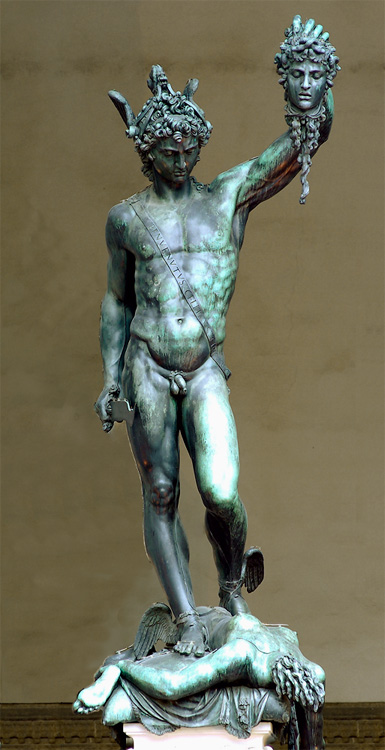 Source: Achilles Tatius, Leucippe and Clitophon, Image: Wikipedia
Source: Achilles Tatius, Leucippe and Clitophon, Image: Wikipedia The harpē sword comes from Greek mythology where Cronus, son of Uranus, used it to castrate his father. The sword is recognizable by the curved sickle protruding near the tip of the blade. Perseus also used a harpē to decapitate Medusa.
Gram
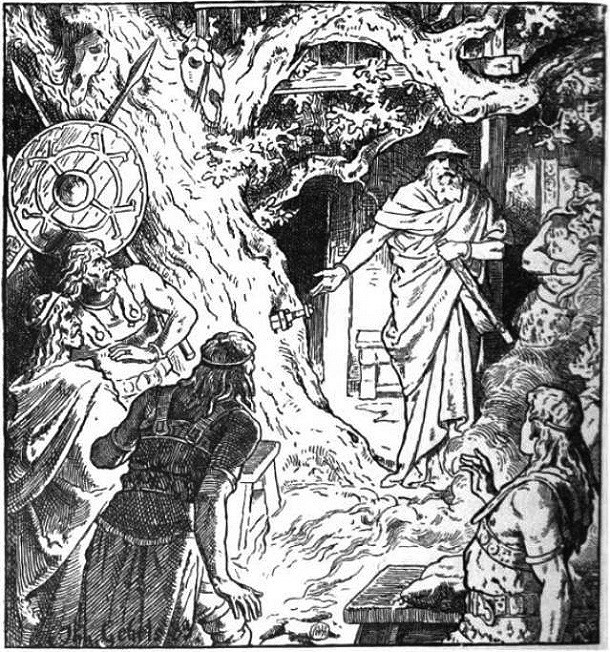 Source: Sigurd—ein Held des Mittelalters (Edgar Haimerl), Image: Wikipedia
Source: Sigurd—ein Held des Mittelalters (Edgar Haimerl), Image: Wikipedia The legendary sword Gram was forced into the tree Barnstokkr by Odin, one of the most persistent and highly regarded gods in both Norse and Germanic mythology. Sigmund the Völsung pulled the sword from the tree and used it to defeat the dragon Fáfnir. Though it broke in battle, after the sword was reforged, it was sharp enough to split an anvil cleanly in half.
Carnwennan
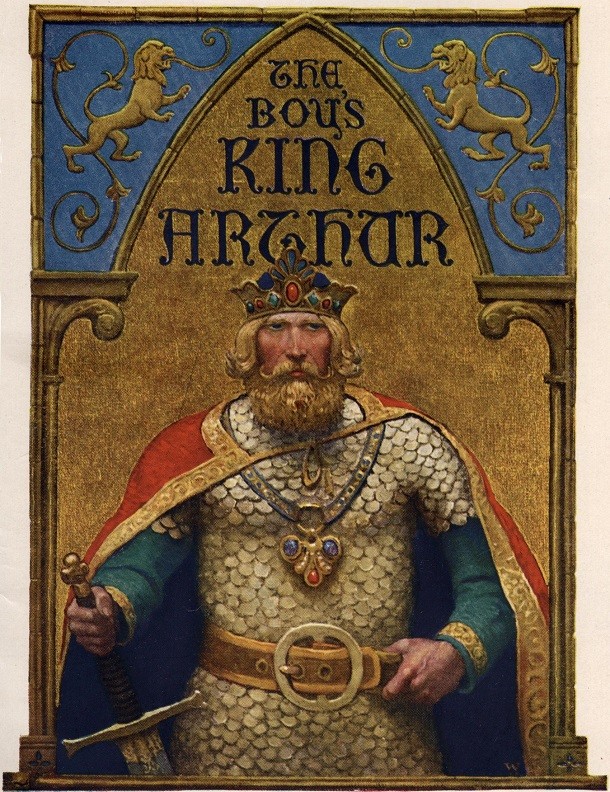 Source: "The Twenty-Four Knights of Arthur's Court", The Welsh Triads, Image: Wikipedia
Source: "The Twenty-Four Knights of Arthur's Court", The Welsh Triads, Image: Wikipedia Legends exist of King Arthur in English storytelling but rarely is King Arthur’s place considered in Welsh storytelling. In it, King Arthur wielded a magical weapon named Carnwennan: a dagger which was reputed to cast its master into shadow. Arthur used it to slice the witch Orddu in half. Welsh legend lists two other objects given to Arthur by the gods – the spear Rhongomiant and the sword Caledfwich (the Welsh name for Excalibur).
Excalibur
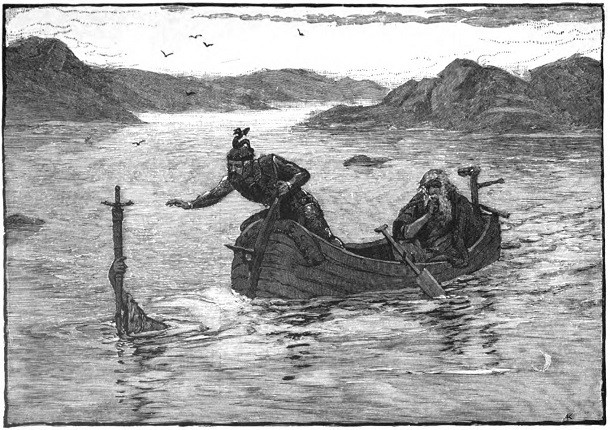 Source: The Works of Sir Thomas Malory & "Merlin" by Robert de Boron, Image: Wikipedia
Source: The Works of Sir Thomas Malory & "Merlin" by Robert de Boron, Image: Wikipedia The better-known weapon of King Arthur, Excalibur, is often associated with the Sword of the Stone, the sword lodged in a boulder which was only able to be pulled out by the true king of England. The sword Excalibur had the power to blind its enemies and its scabbard could prevent the wearer from bleeding caused by wounds inflicted in battle.
Sword of Attila
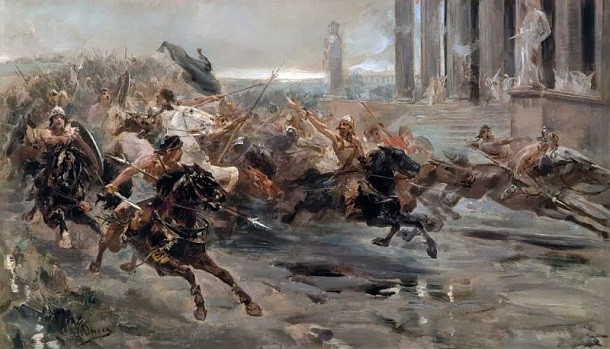 Source: The Origin and Deeds of the Goths & Kunsthistorisches Museum Wien, Image: Wikipedia
Source: The Origin and Deeds of the Goths & Kunsthistorisches Museum Wien, Image: Wikipedia The legendary Hun warrior Attila is said to have been given a weapon by the gods themselves. The Sword of Attila was used by the great military commander in battle and as a symbol of divine favor. A sword some claim is the legendary weapon is housed in the Kunsthistorisches Museum in Vienna, though this sword seems to have been made at least a half millennia after Attila died.
Pasha
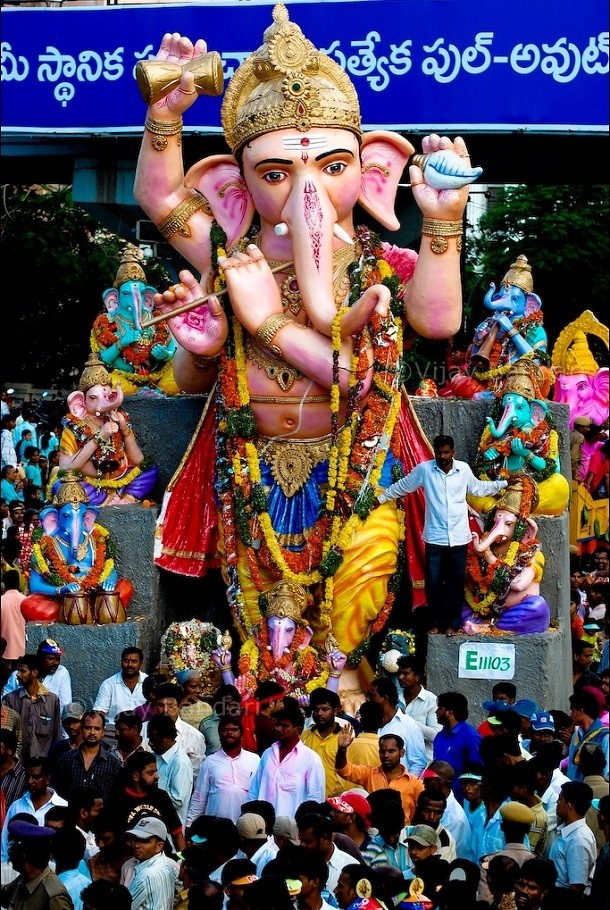 Source: Eva Rudy Jansen (1993). The Book of Hindu Imagery: Gods, Manifestations and Their Meaning. , Image: Wikipedia
Source: Eva Rudy Jansen (1993). The Book of Hindu Imagery: Gods, Manifestations and Their Meaning. , Image: Wikipedia Turning to Hindu storytelling, we find the Pasha, a mythical weapon used by multiple Hindu deities. Ganesha used it to bind and remove obstacles and Yama used it to extract a soul from the body upon death. Often seen as a noose-like loop, the Pasha signifies worldly attachment and the power of the gods to contain and control evil.
Varunastra
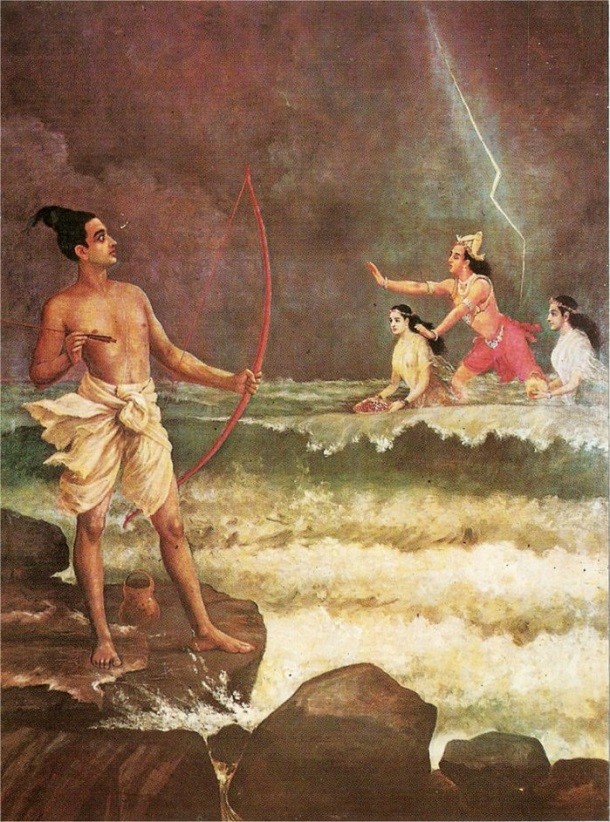 Source: Ramesh Menon (2004), The Ramayana, Image: Wikipedia
Source: Ramesh Menon (2004), The Ramayana, Image: Wikipedia Created by Varuna, the god of water and the ocean, the Varunastra is a mythological weapon able to assume any shape. Made from water, the versatile weapon was said to instantly kill any inexperienced warrior who used it incorrectly.
Joan of Arc's Sword
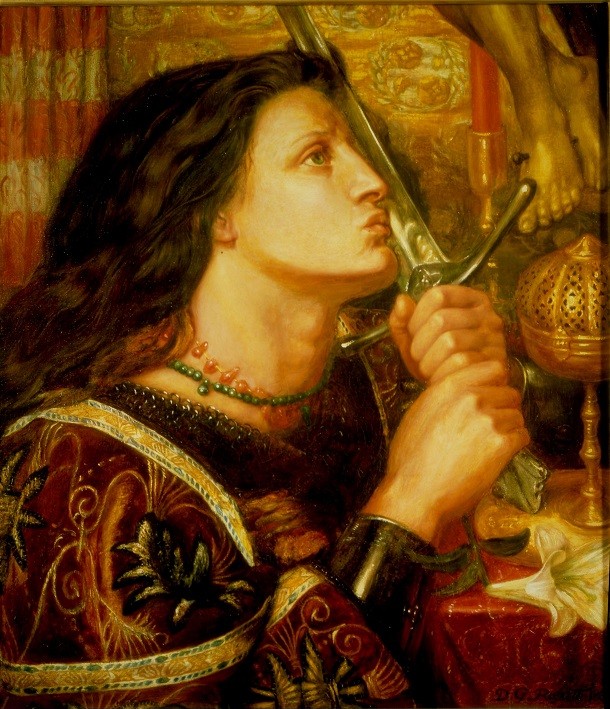 Source: St. Joan Center, Image: Wikimedia
Source: St. Joan Center, Image: Wikimedia Saint Joan of Arc had many visions from saints and from Michael the Archangel, one of which told her to find a holy sword behind the altar of the Church of Saint Catherine of Fierbois. Upon finding it, the rust was easily wiped off the sword and five crosses were revealed. Saint Joan later used the sword in battle, though it is debated whether she actually killed anyone.
Fragarach
 Source: Timeless Myths, Image: Geograph.ie
Source: Timeless Myths, Image: Geograph.ie The Celtic sword Fragarach was said to be forged by the gods themselves and used by Manannán mac Lir, the guardian of the Otherworld and pilot of the boat ferrying souls to the afterlife. The sword was reputed to cut through any armor, give the user control of the winds, and force the truth out of whomever’s throat it was on.
Taming Sari
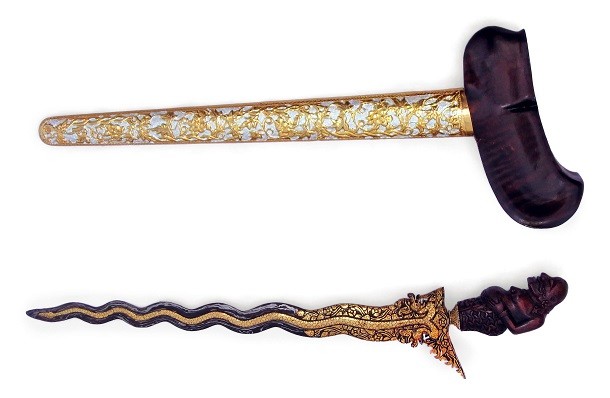 Source: Shellabear, W.G. (1909–1915). Hikayat Hang Tuah., Image: Wikipedia
Source: Shellabear, W.G. (1909–1915). Hikayat Hang Tuah., Image: Wikipedia Legend has it that the Taming Sari grants invulnerability to whomever wields it. This kris – an asymmetrical, wavy dagger – plays a major part in Malaysian mythology, often attributed to the admiral Hang Tuah. Further legends claim the sword could independently shoot out of its sheathe to protect its wielder.
Muramasa Blades
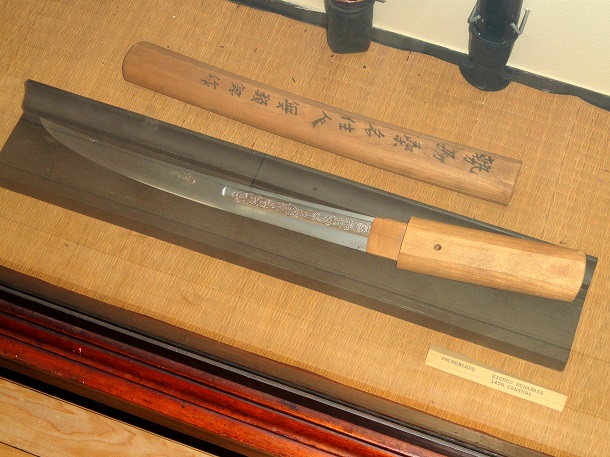 Source: Ancient Origins, Image: Wikimedia
Source: Ancient Origins, Image: Wikimedia The legendary swordsmith Muramasa Sengo was a popular sword-maker in Japan. At the time, it was a commonly held belief that blades received qualities from their forger. Since he was an insane and violent man, the swords made by Muramasa Sengo were imbued with violent qualities, especially the ability to possess their wielders and turn them into deadly warriors. After the shogun’s king and grandfather were killed by the blades, they were banned.
Green Dragon Crescent Blade
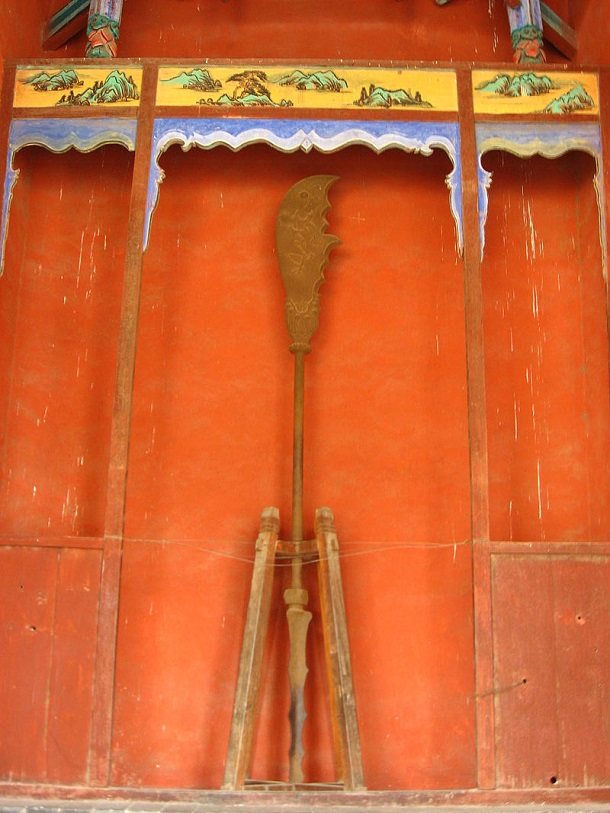 Source: Luo Guanzhong, "Romance of the Three Kingdoms", Image: Wikipedia
Source: Luo Guanzhong, "Romance of the Three Kingdoms", Image: Wikipedia The Green Dragon Crescent Blade was a guandao (a heavy, curved blade with a spike on the back attached to a pole) wielded by the general Guan Yu. The blade was so deadly that it was also known as the Frost Fair Blade since during battles in the snow, the blade would be consistently coated in blood which would freeze into a layer of frost.
Flaming Sword
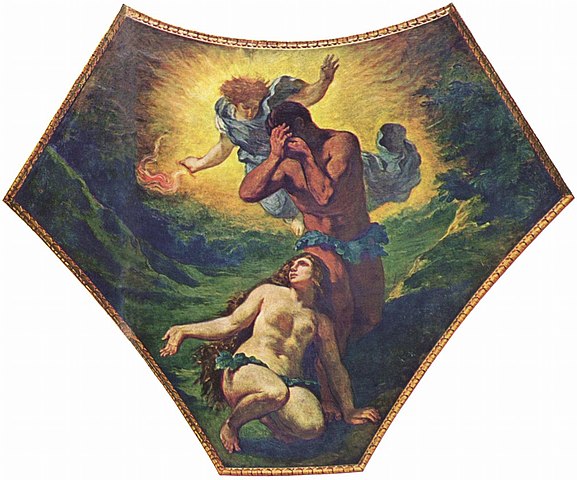 Source: OCF.org, Image: Wikipedia
Source: OCF.org, Image: Wikipedia Various flaming swords exist in lore from around the world. One particular example comes from Eastern Orthodox teachings. The church claims a flaming sword was placed at the entrance to the Garden of Eden when Adam and Eve were expelled. After the crucifixion of Jesus, the sword was said to be removed.
Mjölnir
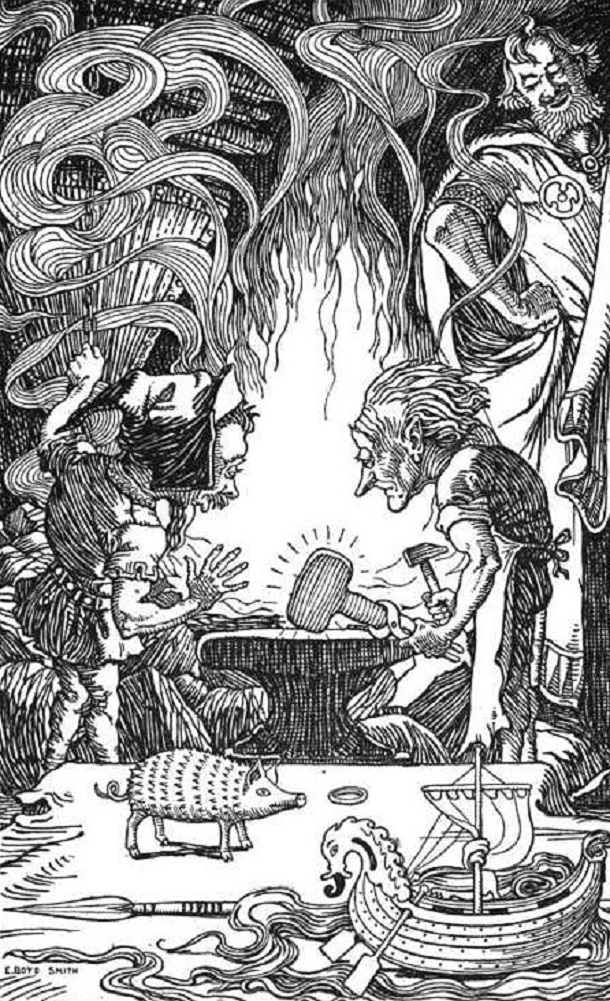 Source: Skáldskaparmál, Image: Wikipedia
Source: Skáldskaparmál, Image: Wikipedia The legendary Norse god of lightning, Thor, wields his powerful hammer: Mjölnir. The hammer was created when Loki challenged two dwarves, Brokkr and Eitri, to create items more beautiful than those created by the Sons of Ivaldi. The dwarven brothers succeeded, despite Loki’s intervention, though the handle was shorter than expected. The hammer was so powerful it could not be destroyed and would return to Thor whenever he threw it.
Gan Jiang & Mo Ye
 Source: Gan, Bao. In Search of the Supernatural: The Written Record, Image: Wikipedia
Source: Gan, Bao. In Search of the Supernatural: The Written Record, Image: Wikipedia The swordsmith couple Gan Jiang and Mo Ye were commissioned by the king to forge him a pair of twin swords in three months. According to the story, since the blast furnace could not melt the metal, the couple concluded there was not enough chi (life force) in it so they cut off their hair and nails and threw them into the fire. Simultaneously, 300 children blew into the bellows. After three years, the swords were forged. Gan Jiang kept the male sword, named after him, to himself and presented the other, Mo Ye, to the king. The king was infuriated and had him killed. Gan Jiang predicted the reaction and left a note for his wife and son (who retrieved the sword and went to kill the king in retribution). Along the way, an assassin sent by the king encountered Gan Jiang’s son (who took his own life). The assassin took the sword and the son’s head to the king. Feeling pity for the boy, the assassin killed the king as well before killing himself. Talk about drama!
Joyeuse
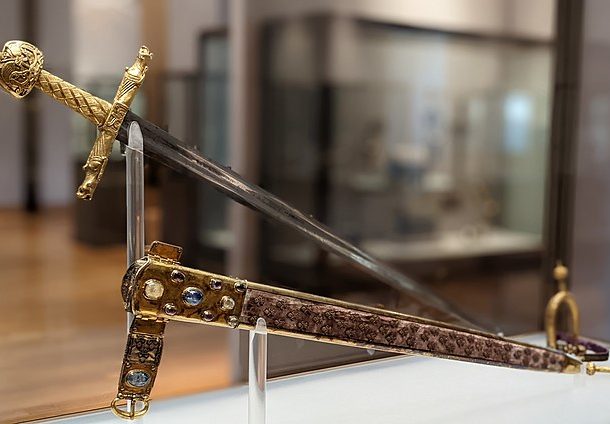 Source: Louvre.fr, Image: Wikimedia
Source: Louvre.fr, Image: Wikimedia Sword of the great King of the Franks Charlemagne (or Charles the Great), Joyeuse was used by the famous historical figure in uniting most of Western Europe. Now housed in the Louvre, the sword was used for French coronations from 1270 for Philip III until 1824 for Charles X.
Durendal
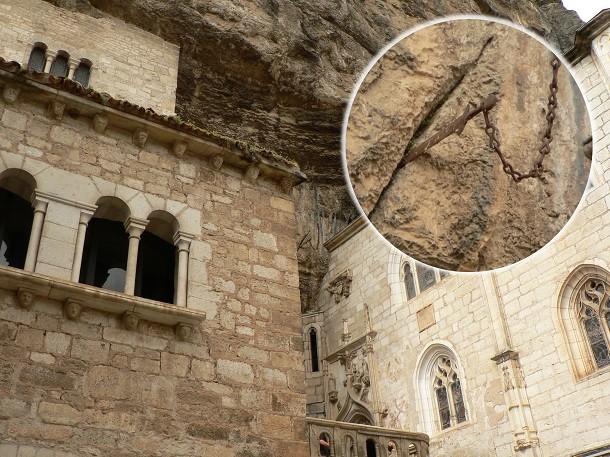 Source: Auty, Robert (1980). Traditions of Heroic and Epic Poetry. & Caro, Ina (1996). The Road From the Past: Traveling Through History in France., Image: Wikipedia
Source: Auty, Robert (1980). Traditions of Heroic and Epic Poetry. & Caro, Ina (1996). The Road From the Past: Traveling Through History in France., Image: Wikipedia Charlemagne’s paladin Roland wielded the powerful sword Durendal. The sword was said to contain a tooth from Saint Peter, hair from Saint Denis, part of the clothing of the Virgin Mary, and blood from Saint Basil. This legendary sword was said to be the sharpest sword which had ever existed, even capable of holding off a 100,000-strong army as the stories say Roland and his small army did. Folklore in southern France claims Roland threw the sword into a cliff wall at Rocamadour, though the tourist office refers to the sword in the cliff simply as a replica.
Caladbolg
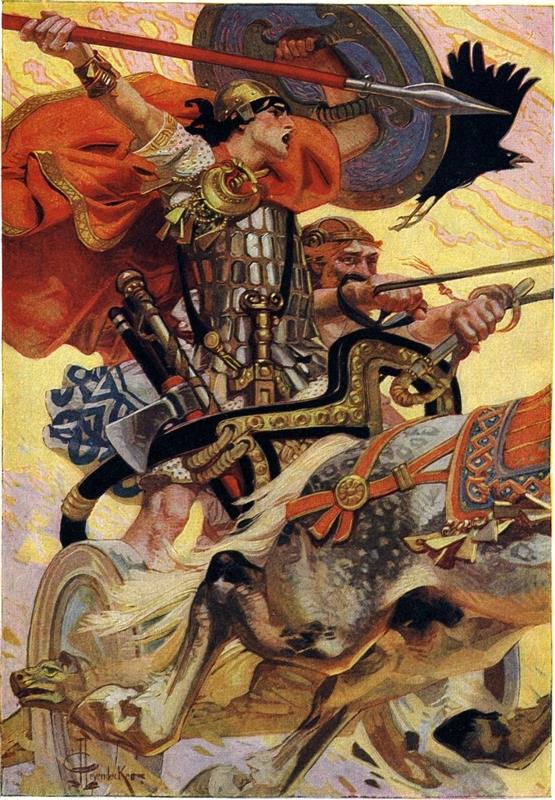 Source: O'Rahilly, T. F., Early Irish history and mythology, Image: Wikipedia
Source: O'Rahilly, T. F., Early Irish history and mythology, Image: Wikipedia The legendary Irish legendary sword Caladbolg was wielded by Fergus mac Róich. The two-handed sword was so powerful that its swinging made a circle like a rainbow which could be used to decimate armies or cut off the tops of hills.
Shamshir-e Zomorrodnegār
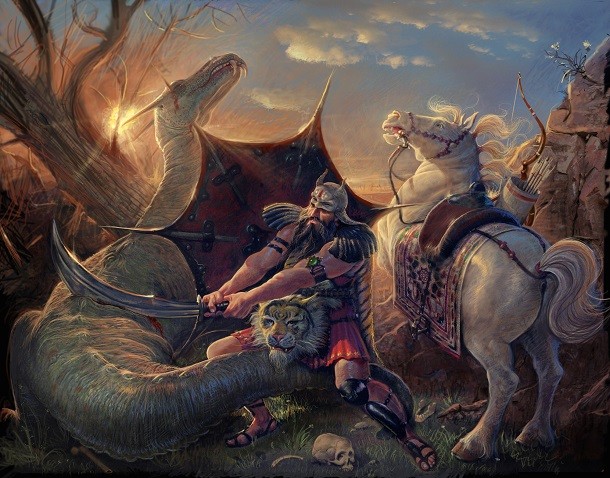 Source: Encyclopaedia Iranica, Image: Wikipedia
Source: Encyclopaedia Iranica, Image: Wikipedia Persian legends tell us of the legendary sword Shamshir-e Zomorrodnegār, originally property of King Solomon. The sword was said to be guarded by Fulad-zereh, a witch and mother of a ferocious horned demon. She protected it so carefully because this legendary mythological weapon was the only thing capable of killing her son. If a person was wounded by Shamshir-e Zomorrodnegār, the wound could only be treated by a potion made from, among other things, Fulad-zereh’s brain.
Thuận Thiên
 Source: Thế Dũng Hàn Lê Lợi: tiểu thuyết lịch sử, Image: Wikipedia
Source: Thế Dũng Hàn Lê Lợi: tiểu thuyết lịch sử, Image: Wikipedia The Vietnamese King Lê Lợi fought and chased the Mings out of Vietnam from 1418-1428. His legendary weapon, the sword Thuận Thiên, translates as “Heaven’s Will”. The sword is said to have increased the king’s size by many fold and given him the strength of a thousand men.
Sharur
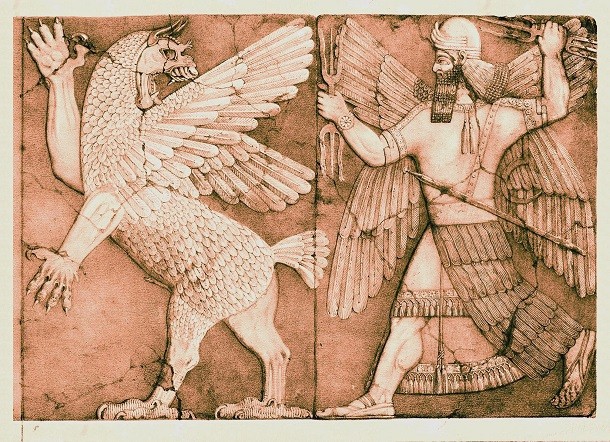 Source: The Exploits of Ninurta (or 'Ninurta Lugal-E'), Image: Wikimedia
Source: The Exploits of Ninurta (or 'Ninurta Lugal-E'), Image: Wikimedia Sharur translates as “smasher of thousands”. The weapon of Mesopotamian god Ninurta, the mace was reputedly able to fly wherever it wished and communicate with Ninurta. It was also used to communicate the will of the god Enlil (a chief deity in Sumerian religion) to Ninurta.
Tizona
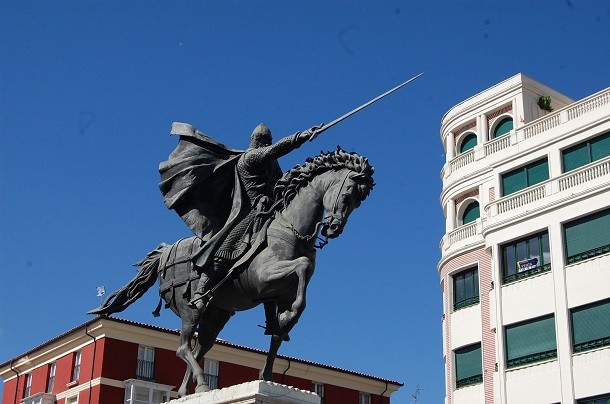 Source: "El valor de un icono", Diario de Burgos & "Cantar de Mio Cid", Image: Wikimedia
Source: "El valor de un icono", Diario de Burgos & "Cantar de Mio Cid", Image: Wikimedia Along with La Colada, the Tizona is one of two legendary swords attributed to Spanish conqueror El Cid which he used to drive the Moors out of the Iberian Peninsula. Immediately aware there was no escaping the mighty blade, El Cid’s opponents would often turn and run from the Tizona. The city of Burgos (near to his birthplace) in Spain acquired what is said to be the sword in 2007.
Ruyi Jingu Bang
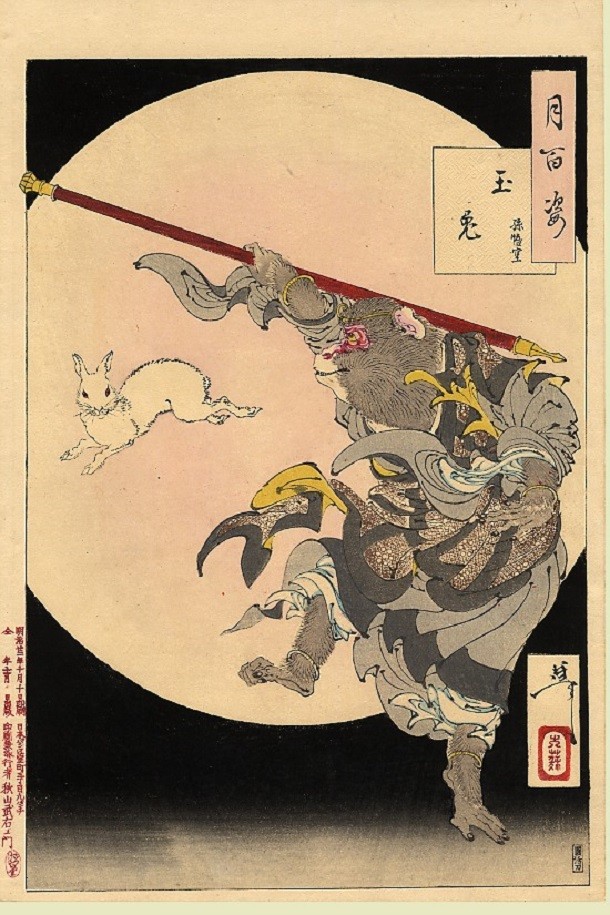 Source: Elvin, Mark. The Retreat of the Elephants: An Environmental History of China. & Wu, Cheng'en, and W.J.F. Jenner. Journey to the West., Image: Wikipedia
Source: Elvin, Mark. The Retreat of the Elephants: An Environmental History of China. & Wu, Cheng'en, and W.J.F. Jenner. Journey to the West., Image: Wikipedia Ruyi Jingu Bang is the magical staff of the immortal monkey king Sun Wukong. The Monkey King went to the underwater kingdom of the Dragon King looking for a weapon to match his strength. After failing to find one, the Dragon Queen suggested to give him a seemingly-useless rod in their treasury which began producing “heavenly light” in the days before his arrival. The rod, weighing 17,550 pounds (7,960 kg), shrank or grew according to Sun Wukong’s will. When unused, the Monkey King shrank it to needle-size and kept it behind his ear.
Sword of Damocles
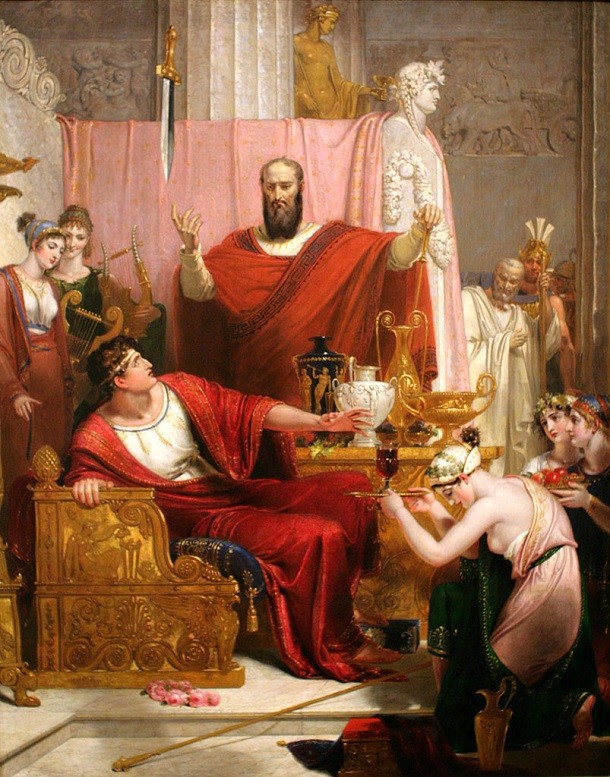 Source: Cicero, Tusculan Disputations, Image: Wikipedia
Source: Cicero, Tusculan Disputations, Image: Wikipedia The story of the Sword of Damocles comes from the history of Sicily as recounted by Timaeus of Tauromenium. Damocles was a courtier in King Dionysius II of Syracuse’s court and was one day lauding praises on the king for his fortune of having so much power and wealth. Dionysius offered to change places with the courtier – a proposal which Damocles quickly accepted. But, to show the perils that come with power, the king had a massive sword hung above the throne by just one hair of a horse’s tail. Damocles begged the king to take back the responsibility.
Pashupatastra
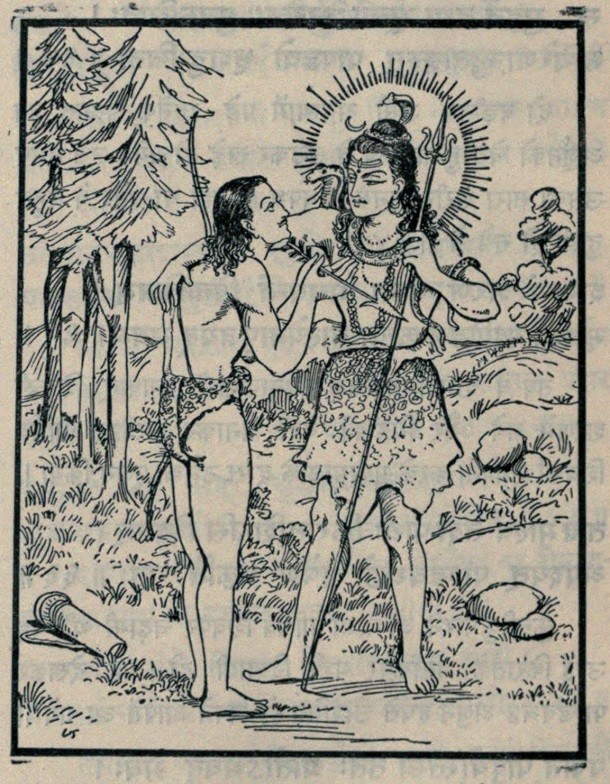 Source: Dictionary of Hindu Lore and Legend, Image: Wikimedia
Source: Dictionary of Hindu Lore and Legend, Image: Wikimedia The Pashupatastra is one of the most powerful weapons in all of Hindu mythology. This legendary weapon – used via the mind, eyes, words, or a bow – is capable of eradicating all living beings and destroying all of creation. The personal weapon of Lord Shiva, the god gave it to the warrior Arjuna. Knowing better, Arjuna refrained from using the Pashupatastra lest he destroy the entire world.



























